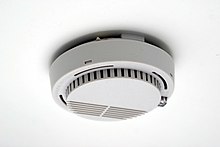
Back كاشف الدخان Arabic Deteutor de fumu AST Detector de fum Catalan ᏚᎦᏒᏍᏛ ᎦᏃᏣᏢᏍᎩ CHR Detektor kouře Czech Røgalarm Danish Rauchmelder German Detector de humo Spanish Suitsuandur Estonian آشکارساز دود Persian

A smoke detector is a device that senses smoke, typically as an indicator of fire. Smoke detectors/Alarms are usually housed in plastic enclosures, typically shaped like a disk about 150 millimetres (6 in) in diameter and 25 millimetres (1 in) thick, but shape and size vary. Smoke can be detected either optically (photoelectric) or by physical process (ionization). Detectors may use one or both sensing methods. Sensitive alarms can be used to detect and deter smoking in banned areas. Smoke detectors in large commercial and industrial buildings are usually connected to a central fire alarm system.
Household smoke detectors, also known as smoke alarms, generally issue an audible or visual alarm from the detector itself or several detectors if there are multiple devices interlinked. Household smoke detectors range from individual battery-powered units to several interlinked units with battery backup. With interlinked units, if any unit detects smoke, alarms will trigger at all of the units. This happens even if household power has gone out.
Commercial smoke detectors issue a signal to a fire alarm control panel as part of a fire alarm system. Usually, an individual commercial smoke detector unit does not issue an alarm; some, however, do have built-in sounders.
The risk of dying in a residential fire is cut in half in houses with working smoke detectors. The US National Fire Protection Association reports 0.53 deaths per 100 fires in homes with working smoke detectors compared to 1.18 deaths without (2009–2013). However, some homes do not have smoke alarms, and some do not have working batteries in their smoke alarms.[1]
- ^ "Smoke Alarms in U.S. Home Fires". nfpa.org. September 2015. Archived from the original on 2017-07-29. Retrieved 2017-07-28.
© MMXXIII Rich X Search. We shall prevail. All rights reserved. Rich X Search